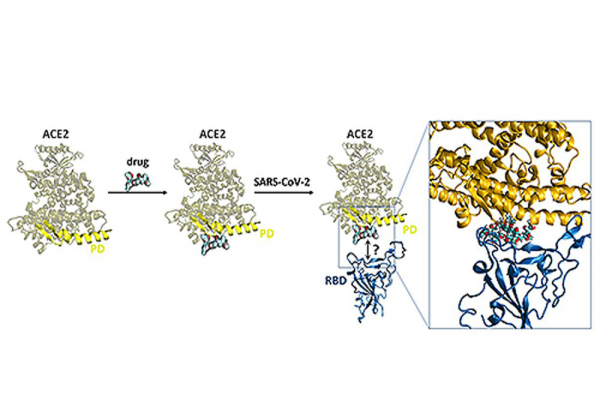Marco Marazzi: 'Molecular modeling could allow the pieces of this complex puzzle that is the SARS-CoV-2 to be described in detail'
Marco Marazzi is an assistant professor Doctor in the research group Reactivity and Molecular Structure (RESMOL) at the UAH. In this interview, he discusses for uah.es noticia the main advances in research to improve the treatment of COVID-19, in which he is working.
This research project belongs to the patronage actions that are being funded and disseminated from Universidad de Alcalá. As part of its social commitment, the UAH works in the search for solutions to COVID-19 from research and education.
- What is your task in the project you are doing? How does UAH collaborate in the development of this study?
Like the other team members involved in the project, I am investigating the molecular mechanisms responsible for SARS-CoV-2, with the aim of finding possible drugs against COVID-19.
UAH has created a sponsorship plan to secure funding for various projects, including this. In addition, it has launched its own program of funding COVID-19 projects, which we have chosen and are awaiting the resolution. It also helps in the dissemination of the objectives that we have set ourselves, through different actions on its website and social networks.
- How many agencies and institutions are you involved in the project? How have the collaborations between the different entities been forged? Did previous collaborations exist between the different authors?
This project was born from the concern of several scientists about the events produced by COVID-19 in early March. Especially as an Italian, I saw from Spain what was happening in my country. I began to wonder what could have been done at the research level.
At the UAH, I contacted Cristina García, who belongs to the RESMOL group (Reactivity and Molecular Structure), and Isabel Iriepa, of the DISCOBAC group (Design, Interaction and Synthesis of Biologically Active Compounds). Initial ideas emerged on how to study the possible mechanism of infection through the techniques we know.
 |
| Marco Marazzi |
At the same time, we contacted the Université de Lorraine (France), a group with which I made a postdoctoral stay. This French research group, together with its collaborators at the Università degli Studi di Palermo (Italy), were ready to join forces and propose alternative ideas. As soon as I started building the first models, I was in contact with Antonio Francés, researcher at the Universidad de Valencia, who I met in France and who also joined the challenge.
These institutions form the core of the project to develop the theoretical part in all its aspects. In addition, thanks to the collaboration of Prof. Isabel Iriepa, we also have the support of CSIC, both the Institute of Organic Chemistry, and the National Center for Biotechnology, which will allow us to find out the experimental efficacy of the drugs and mechanisms that we propose.
- Study methodology, what benefits can the study produce in the short term? What´s about the long term?
We propose several methodologies belonging to molecular modeling and simulation. These computational techniques are capable of offering unprecedented spatial resolution, coming to understand at the atomic level biological structures of a complex nature, such as proteins and their interactions.
In the short term, that is, in a few months, we will have the possibility to simulate these processes and reduce both time and costs. In the long term, the details that can be achieved with these techniques could allow to describe carefully all the pieces of this complex puzzle that is the SARS-CoV-2, to understand the structural relationships with the previous SARS-type outbreak (SARS-CoV) in 2002, and this way to allow an early study of its evolution, to be able to propose in time the corresponding antivirals. In short, it might be useful so that it does not catch us unprepared as this time has happened.
- A lot of research is currently underway regarding COVID-19 treatment. How is your study different from the rest? What do you expect you to contribute?
The world of molecular modeling is made up of a multitude of different techniques, each focused on answering a specific type of question. This also explains why our project brings together institutions from three European countries, requiring experts in different areas of modelling: techniques are needed to propose what sites are interaction sites of potential drugs, such as docking, used assiduously in the pharmaceutical industry.
With molecular dynamics, we can describe how our system behaves over time, allowing us to accurately describe its evolutions and reorderings. In some cases, even more sophisticated techniques are necessary to estimate the efficiency of the drugs we are proposing. Ultimately, it will be the experiment that will provide us with information to validate and, if necessary, to improve our proposals.
-Tips for AlumniUAH that dream of carrying out an important project such as the one you carry out. What do you recommend to students who are in the process to get to do research like this?
If you are excited about research, I am sure that any student can have very interesting ideas for and fight for future projects. It is essential, in my view, to have experiences abroad in order to learn new techniques and new ways of proposing solutions to scientific problems.
In this specific case, this project could never have been implemented without the necessary synergy between different institutions in different countries. At a historic moment when union policies in Europe seem to be hesitant, I would like to see how science benefits enormously from common projects, and hopefully they can always be more.
Publicado en: Inglés
